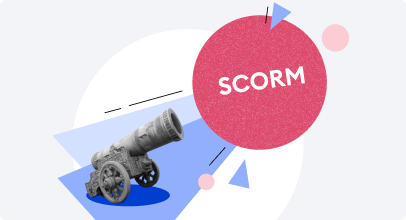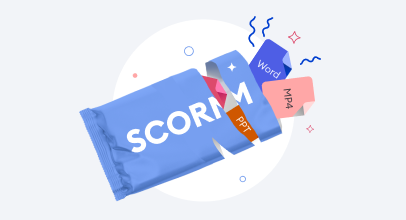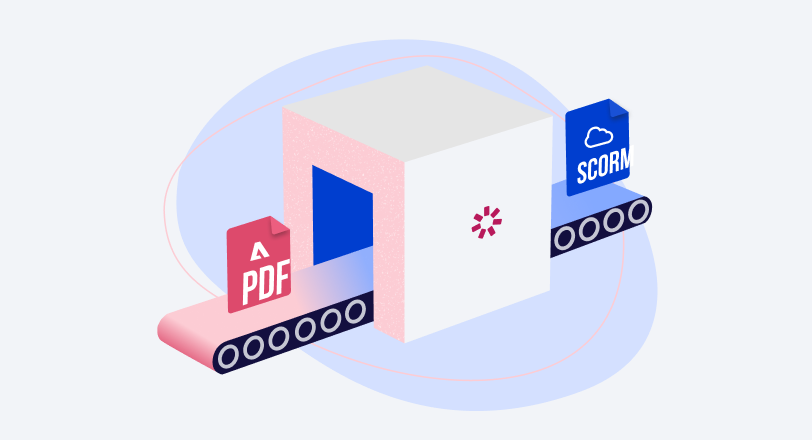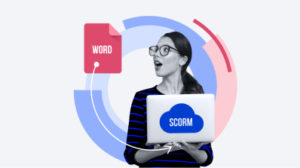xAPI vs. SCORM: Choosing the Right Standard
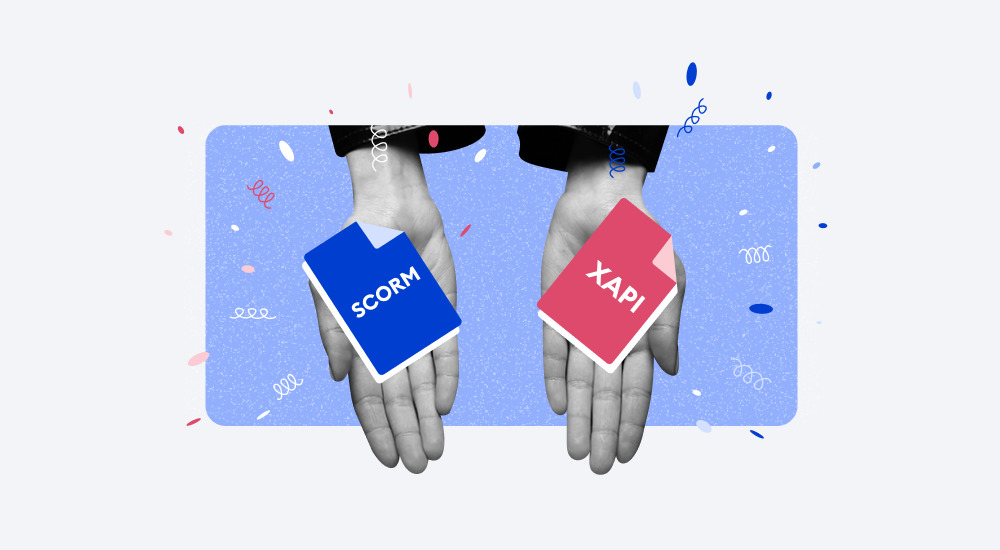
If you’re involved in L&D, you’ve probably come up against this common conundrum: xAPI vs. SCORM. These two eLearning standards play a crucial role in how we track and capture learning data. As such, understanding the differences between the two specifications is a must.
Our guide delves into everything you need to know to choose the right standard for your needs, including:
- Definition and benefits of SCORM
- Definition and benefits of xAPI
- Tracking capabilities of both xAPI and SCORM courses
- Recommendations when choosing between xAPI and SCORM
What Is SCORM?
SCORM, which stands for Shareable Content Object Reference Model, is a set of technical eLearning standards. These industry specifications offer a framework for creating, packaging, delivering, and tracking eLearning content. That way, learning materials are compatible and functional on different learning management systems (LMSs). In short, the primary goal is to create seamless communication and integration between eLearning content and LMSs.
One of the most notable features of the SCORM standard is its ability to track and report learner progress, standardizing how this data is communicated between eLearning content and learning platforms. For instance, you can monitor content completion status, test scores, and other key performance indicators.
Typically, SCORM-compliant courses are organized into modules, with each one containing interactions, multimedia elements, and assessments. These modules are saved as a SCORM package in a standardized format that is easily imported into learning management systems.
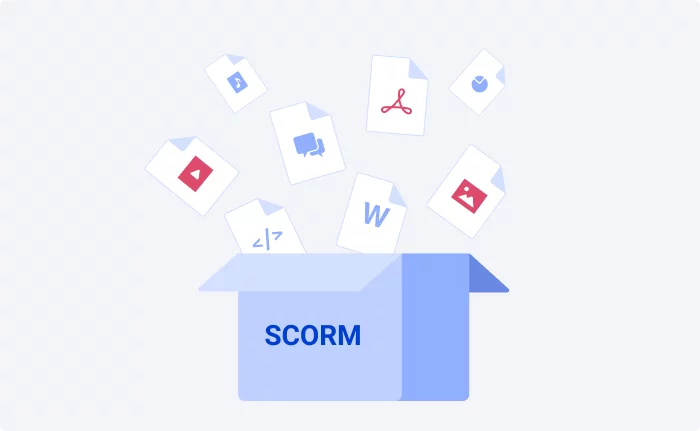
Since the content is packaged using SCORM standards, it’s easily shared and reused across different systems (provided that they are SCORM compliant). This reduces content development costs and provides a consistent learning experience across multiple platforms and mobile devices.
There are three existing versions of SCORM: 1.1, 1.2, and 2004. The first version, SCORM 1.1, was is not widely adopted. But SCORM 1.2, which was introduced in 2001, remains relevant and is widely used today. A more advanced edition, known as SCORM 2004, was introduced in 2004. With its enhanced features, it has become the most commonly used SCORM standard.
Benefits of SCORM
As mentioned, SCORM is widely accepted as the eLearning industry standard, and for good reason. Here are some of the greatest benefits of SCORM content.
- Industry backed: Has widespread industry support, meaning there is a wealth of information, assistance, and resources for implementing it.
- Highly consistent: Provides a standardized framework for delivering eLearning programs, thus ensuring that training is consistently of high quality.
- Great compatibility: Integrates seamlessly with multiple learning platforms and devices, creating an easy and accessible training experience.
- Reusable: SCORM-compliant content is easily shared and reused across different systems, thereby reducing the costs of content development.
- Robust reporting capabilities: Allows for the tracking of key metrics, such as course completion status, learner progress, and test scores.
- Scalable: As an industry standard, it supports the growth of online training initiatives without compromising on functionality or learner experience.
What Is xAPI?
xAPI, which stands for Experience API, is a standard that enables you to collect and track data about a learner’s interactions, activities, and achievements across different digital learning platforms and devices. Also known as Tin Can API, it offers a framework for gathering and sharing learning data, such as resources accessed, actions performed, time spent, assessments completed, and outcomes achieved.
While its SCORM predecessor concentrates on tracking training assessment scores and completion rates in a learning management system (LMS), xAPI provides a more thorough insight into learner experiences. For instance, it offers detailed information about when learners access training content and how they interact with it.
This is done through xAPI (or Tin Can) statements, which allow for the collection and sharing of granular data about learner experiences, behaviors, and outcomes. These statements provide a flexible and comprehensive way to track learning activities.
xAPI statements are made up of three main elements:
- An actor (who performed the action) — usually identified by a user ID or email address
- A verb (the action) — “completed,” passed,” “attended,” “interacted,” etc.
- An object (the target of the action) — typically a course, module, quiz, video, or another learning resource that is identified by a unique URL or activity ID
An example of an xAPI statement could be: “Susan passed the quiz.”
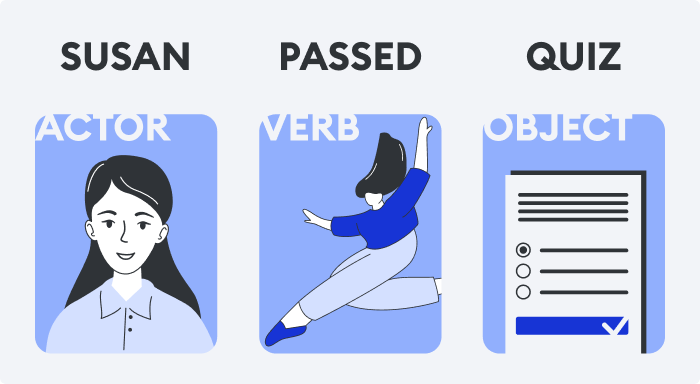
If necessary, additional metadata can be included in the Tin Can statement to supply more context and details about the learning experience.
Benefits of xAPI
xAPI might be the newest eLearning standard on the block, but does that make it worth utilizing in your learning process? We’ve rounded up the most notable benefits of Tin Can API to help you make that call.
- Advanced tracking capabilities: Tracks learning experiences beyond eLearning courses, collecting data from training simulations, mobile apps, and games.
- Enhanced interoperability: Captures data from various learning systems, enabling seamless integration and the ability to consolidate data.
- Detailed insights: Provides comprehensive information about learner behaviors, preferences, and performance outcomes.
- Scalable: Flexible enough to scale with new technologies and standardizations.
- Multiple data formats: Supports a broad range of formats (text, timestamps, attachments, etc.), enabling more detailed capturing of learner data.
- Personalized learning: Allows designers to build highly personalized learning experiences based on individual learner needs, behaviors, and preferences.
All of these benefits empower eLearning content developers to make more informed, data-driven learning decisions.
xAPI vs. SCORM: What You Can Track
Perhaps the biggest question when comparing xAPI and SCORM 2004 is about their tracking capabilities. Understanding how each standard works in terms of tracking learning-related activity makes it easier to identify which specification best aligns with your organizational needs. So, we’ve created a table comparing the tracking capabilities of SCORM courses and Tin Can API.
| xAPI | SCORM 2004 | |
| Learner data | Advanced tracking of learner experiences across multiple platforms | Tracks course completion and test scores |
| Interactions | Records granular data on learner interactions | Basic tracking of course progress |
| Media usage | Captures use of multimedia elements and resources | Limited capability to capture multimedia usage |
| Assessment | Records detailed assessment data — can record multiple scores | Records assessment scores |
| Social | Supports the in-depth capturing of social learning interactions | Limited support for tracking social activities — in some cases, forums and chat can be integrated with SCORM content |
| Offline | Facilitates the tracking of offline learning experiences | Primarily designed to track online learning |
| Adaptive | Supports highly adaptive learning pathways | Supports high-level personalized learning paths |
As you can see from the chart above, xAPI provides a complete picture of eLearning activities across multiple platforms and systems. This includes deep insights into specific behaviors, such as the total time spent on an interaction, video views, use of knowledge bases, and interactions with social learning resources.
Conversely, while data from SCORM courses are limited by comparison, this standard covers all the key tracking metrics that most organizations need. Moreover, it’s a more accessible and straightforward way to capture data on employee training.
Also read: 17 Key Recruiting Metrics and How to Improve Them with Online Training
How to Choose Between xAPI and SCORM
Knowing the difference between SCORM vs. xAPI is an important first step in making informed decisions about the tools and content you choose for your eLearning initiatives. However, there are other factors to consider when deciding which standard best aligns with your organization’s needs. To facilitate the selection process, we’ve compiled a few approaches to implement when it comes to deploying Experience API or SCORM courses.
1. Assess your needs
The first step in choosing between SCORM and Tin Can is to conduct an exhaustive analysis of your organizational needs. Consider the level of detail you need from data tracking, the type of learning experiences you plan on deploying, and how compatible each standard is with your existing systems. Thoroughly assessing your needs will help you make a more informed decision that aligns with your business goals, budget, and level of in-house expertise.
Here’s an example of some common requirements.
| Need to Know | SCORM | xAPI (Experience API) |
| Video views | Tracks completion of video only | Tracks time spent on video and number of views |
| Quiz responses | Records answers, scores, and the time taken to answer | Records individual question responses, scores, the time taken to answer, and other relevant data |
| Course completion rates | Tracks overall eLearning course completion rates | Tracks detailed completion status (captures activity on specific elements or sections within the training) |
| Interaction with learning materials | Captures limited data on predetermined interactions only | Captures granular data on user interactions (clicks, navigation, activity on drag-and-drop exercises, etc.) |
| Time spent learning | Reports the total time spent on a module or course | Provides granular tracking of time spent on individual activities in a module or course |
| Completion of learning objectives | Records when a learner completes objectives | Records detailed information on which objectives a learner has completed and what that objective covers (policies, topics, regulations, etc.) |
2. Plan for the future
Forecasting future needs can help you make the right decision in the present. On one hand, xAPI is a more flexible and adaptable new technology. On the other hand, SCORM has widespread adoption and compatibility in its favor. What it really comes down to is how you see your organization’s learning initiatives growing. Will the standard you choose support that future growth and allow you to reach your long-term goals?
A great way to future-proof your L&D strategy is to select tools that support both standards. For example, iSpring Suite is a high-powered content authoring tool that integrates content seamlessly with both SCORM and xAPI (Tin Can). Because of iSpring’s advanced capabilities, you can stick with tried-and-true SCORM content for the moment, and leave the door open to harness the advanced tracking features of xAPI down the line.
iSpring Suite
Fully-stocked eLearning authoring toolkit for PowerPoint. No training required to start!
With iSpring, you can design interactive, engaging, and customizable eLearning content in a matter of minutes, and export it using the standard that meets your requirements. Once you have created your content (think online courses, video lectures, role-play simulations, and quizzes), you simply select the format of your choice.
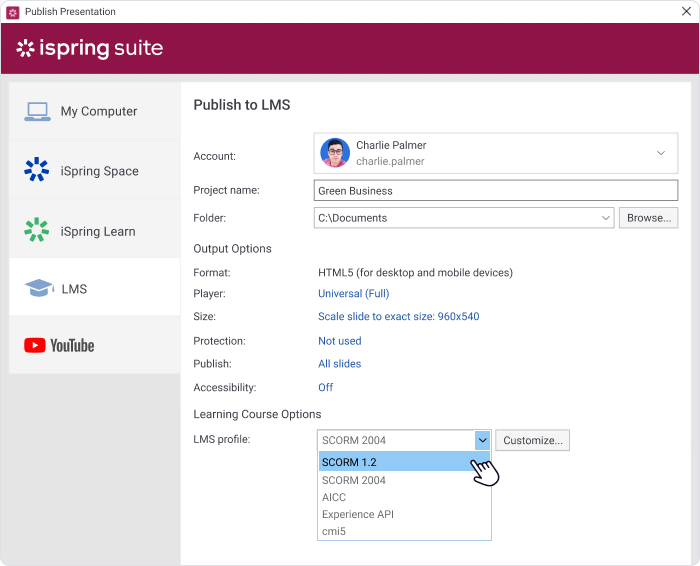
3. Evaluate reporting capabilities
Reporting is a big factor in the xAPI vs. SCORM debate. While both options offer comprehensive tracking capabilities, there’s a difference in the depth and granularity of the analytics. So, getting clear on your organization’s reporting requirements is crucial. That includes understanding what analytics tools would be required for each standard and the level of detail needed.
Here are some real-life examples to illustrate this point.
Let’s say you’re in charge of training in the aviation industry. Plane simulators (powered by virtual reality) are one of the most popular types of training for pilots and airline workers. In this use case, you will want to track detailed data on learner activity and behaviors during the simulation, such as which physical buttons learners pressed during landing. Considering the depth of the data you need in order to capture this information accurately, xAPI could be the best option.

A glimpse of the Peninsula Tokyo flight simulator experience
Now let’s imagine you’re deploying sales training simulations. What you want to know here is how each learner answered each stage of the scenario and if they passed the simulation. In this case, a SCORM package more than covers your needs, providing clear insight into learners’ weak areas.

A fragment from a role-play simulation created with iSpring Suite
4. Consider the implementation process
Factoring in the implementation process for Tin Can vs. SCORM is a crucial step in the decision-making process. So, take time to assess which tools, resources, and expertise you will need to create and deliver learning content with each standard.
Doing this gives you a clear picture of the level of support (internal or external) you’ll need to launch and manage your eLearning programs. Is community support and guidance available? How long is the implementation process likely to take with each option? These questions will shape your final decision.
We’ve compiled a table of the common tools needed to develop and deploy learning content using each specification.
| Tools | SCORM | xAPI (Experience API) |
| Learning management system (LMS) | SCORM-compliant LMS | xAPI-compliant LMS or an LRS (Learning Record Store |
| Content authoring tool | SCORM authoring tools | xAPI-compliant authoring tools |
| Learning Record Store (LRS) | N/A | Needed to store and track xAPI statements (some LMSs have built-in LRSs) |
| xAPI Client Libraries/SDKs | N/A | Required to create and send xAPI statements from your learning content to the LRS |
| Reporting and analytics tools | SCORM-compliant reporting tools (typically built into the LMS) | In some cases, an additional xAPI-compliant reporting and analytics tool is needed to provide advanced insights into the data |
Also read: 12 LMS Benefits For Recruiters, HR, Sales and Commercial Directors—Expert Opinion
Conclusion
We hope this guide has shed some light on the differences between xAPI vs. SCORM. While Tin Can has emerged as the latest and most advanced specification, SCORM remains the common industry standard. At the end of the day, opting for the most modern industry standard doesn’t always make the most sense for your organization’s needs, resources, and experience level.
In some cases, sticking with a tried-and-tested specialization such as SCORM will garner the best results. Not only does it cover all of your requirements and use cases, but it allows you to focus on what really matters — the learning process. In contrast, if your company has high aspirations to build learning experiences with serious games and virtual reality, or you need exhaustive test results, xAPI (Tin Can) could be your best bet.
Haven’t made up your mind? Keep your options open with an authoring tool that supports both SCORM and Tin Can like iSpring Suite. Request your 14-day free trial today.




